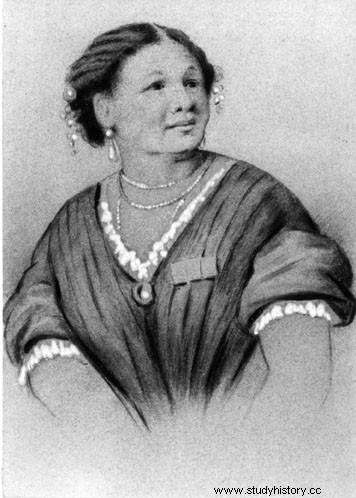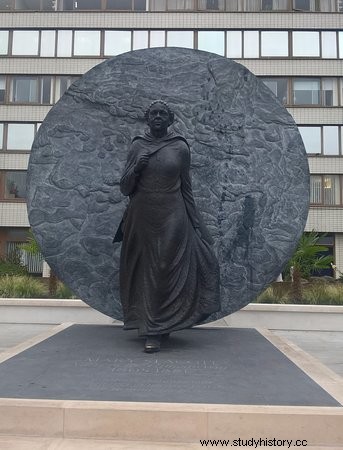In 1907 Florence Nightingale she became the first woman to receive the Order of Merit, the highest British civil distinction; International Nursing Day is celebrated on May 12, the anniversary of her birth; nurses take the Florence Nightingale Oath and there is even Florence Nightingale Syndrome. If we add to all this that when he returned from the Crimean War he opened a School of Nursing at Saint Thomas Hospital in London in 1860, which is still in operation today, and that he drew up a health protocol that ranged from the training of nurses or the resource management to hospital administration, it is easy to understand that Florence Nightingale is considered the forerunner of modern Nursing, far beyond simple patient care.

Florence Nightingale
The problem is that her role could overshadow, and in fact has done so for more than a century, the role of another contemporary "colleague" who, with fewer resources and all possible obstacles, including her race, was the protagonist of a feat, possibly, of greater merit. This is the story of Mary Seacole .

Mary Seacole
Born in 1805 in Jamaica, she was the daughter of a Scottish soldier and a Jamaican healer who ran an establishment in Kingston, where the needy and ill without resources came, whom her mother cared for free, alcohol was dispensed and a bed was provided for the that they could pay. Mary learned all the traditional remedies that her mother's family had inherited from her for generations and began working with her in that establishment, halfway between business and charity. She traveled through various countries of the American continent and even reached Great Britain in her desire to expand her knowledge. After returning from her tour, she got married and set up a shop with her husband which, shortly after, was destroyed by a fire. In 1844, a terrible year for her, she lost her mother and her husband, and had to reinvent herself. She had no choice but to practice as an itinerant healer and move wherever her services were required. A terrible cholera epidemic in Jamaica and the typhus that was devastating the workers of the Panama Canal brought her back to prominence and allowed her to accumulate some capital. Her dedication and her efforts in the cholera epidemic in Jamaica helped her to gain prestige and, in addition, the affection of the people. Her work as her healer went further. She not only administered medicines, she also offered comfort to the dying, she always attended with a smile, she had a word of encouragement, a hug of "you are not alone" or a shoulder to cry on. When the company that was building the Canal required her services, she was there. Of course, this time charging.

Mary heard about the outbreak of the Crimean War while in Panama and she knew that in a war all help is little. So, she traveled to London and volunteered to go to Crimea as a nurse. Although she had a certain prestige across the pond, for the War Office she did not have enough preparation. The reality was crueler than that cheap excuse, it had to do with the color of her skin. The British government must have thought that the wounded would resent being treated by a colored woman. How wrong they were! Given the government's refusal, she even wrote a letter to Florence, who was already in Crimea with 38 more nurses and the support of the British government. There was no answer. So, with all the doors of the official channels closed, she wrapped the blanket around her head and paid for the trip herself.
A 50-year-old woman of color, alone, without any support and in the middle of a war that, moreover, was not hers. Honestly, that looked bad. It is logical to think so, but Mary was made of another paste, the paste of the heroines. As soon as she arrived, she appeared before Florence to offer her services again and, although with good words and thanking her for her help, she rejected her. She had no choice but to settle on her own. With the last money she had left she opened an establishment called British Hotel . It was… it was a bit of everything, like her mother's. It had a large room where the sick and wounded were treated. Logically, with the medicines that she brought from Jamaica, and she also had an area where she could have a drink, eat something or get a haircut. A multipurpose room where you can take a break in the middle of a war. In addition, Mary became a getter, she could get you tobacco as well as lemonade. Her detractors said that this establishment was far from being a hospital and she was far from acting like a nurse, and that she also charged. The reality is that Mary did not wait for the wounded to arrive -by the way, her establishment was much closer to the front than the hospital in Florence-, Mary frequently went to the front, where the bullets whistle and kill, and the served there. And if they had no remedy, she stayed with them until they closed their eyes. And yes, she charged at her hotel, but what each one could pay and only for what she got them and the services that had nothing to do with that of a healer. In fact, do you think the soldiers would have called “Mama Seacole ” to someone who took advantage of them or the situation of the war? The beach bar she had set up and the natural remedies that Mary used squeaked Florence, but she also recognized that she had merit in what she did and the value she gave her. And for Mary… well, she was going about her business. She tried to help by following the official channels and since they didn't let her, she did it her way.
When the war ended, she returned to England with one hand in front of her and one behind her. Without money and without any recognition from the authorities. And do you know who reacted to that shame? Well, the soldiers who had fought in the Crimea. When they learned of her situation, they organized a fundraiser for her former guardian angel. It is said that even Florence made a donation and, although it is not known for sure, I want to believe that it was so. And since she was a determined woman and that she knew how to pull the chestnuts out of the fire, she took advantage of the pull and published a book with her memoirs, “ The wonderful adventures of Mrs. Seacole ”, which allowed her to live with dignity until the end of her days in 1881.
Mary's contribution to medicine and nursing was minimal, if not nil, as doctors rejected her herbal remedies, but the psychological impact she had on the front-line men was brutal. Her willingness to risk even her own life, simply to offer a kind word to a dying man, made the soldiers adore her.
Florence was respected, Mary was adored.

Mary's moment of glory didn't come until 2004, when, after being voted the most important black person in British history, a campaign was launched to fund a statue in her honour. It took seven years to raise the money to carve the first public statue of a black woman in the UK, and it was placed in front of Saint Thomas Hospital. Interestingly, the hospital where the School of Nursing that Florence founded is located. The most fanatical supporters of the figure of Florence say that placing the statue there is a provocation, that calling Mary Seacole a nurse is sacrilege and that this recognition is simply a symbol of political correctness towards people of color. Come on…
Salman Rushdie, in his work “The Satanic Verses ”, I was already saying…
[…] Here is Mary Seacole, who in the Crimea did as much as another wonderful nurse but, being dark-skinned, she was hardly seen, next to the bright flame of Florence.
